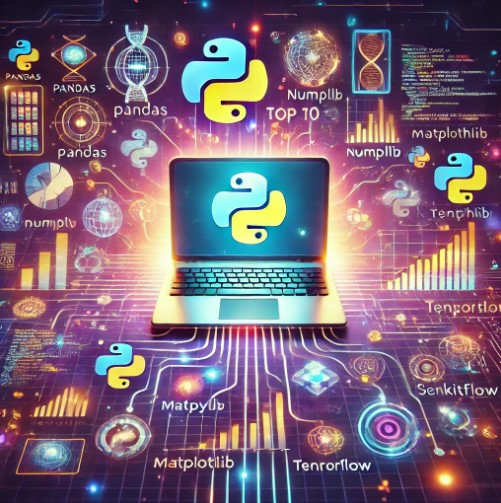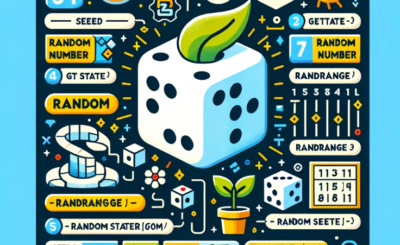Table of Contents
Introduction
Python continues to dominate the field of data science in 2024, offering powerful libraries that streamline everything from data analysis to machine learning and visualization. Whether you’re a seasoned data scientist or a newcomer to the field, leveraging the right tools is key to success. This article explores the top 10 Python libraries for data science in 2024, showcasing their features, use cases, and practical examples.
Top 10 Python Libraries for Data Science in 2024
1. NumPy
Overview
NumPy (Numerical Python) remains a cornerstone for scientific computing in Python. It provides robust support for multi-dimensional arrays, mathematical functions, and efficient operations on large datasets.
Key Features
- Multi-dimensional array manipulation.
- Built-in mathematical functions for algebra, statistics, and more.
- High-performance tools for linear algebra and Fourier transforms.
Example
import numpy as np
# Create a NumPy array
data = np.array([1, 2, 3, 4, 5])
# Perform operations
print("Mean:", np.mean(data))
print("Standard Deviation:", np.std(data))2. Pandas
Overview
Pandas is a game-changer for data manipulation and analysis. It simplifies working with structured data through its versatile DataFrame and Series objects.
Key Features
- Data cleaning and transformation.
- Handling missing data.
- Powerful grouping, merging, and aggregation functionalities.
Example
import pandas as pd
# Create a DataFrame
data = pd.DataFrame({
'Name': ['Alice', 'Bob', 'Charlie'],
'Age': [25, 30, 35]
})
# Analyze data
print(data.describe())
3. Matplotlib
Overview
Matplotlib is a versatile library for creating static, animated, and interactive visualizations.
Key Features
- Extensive plotting capabilities.
- Customization options for axes, titles, and styles.
- Compatibility with multiple file formats.
Example
import matplotlib.pyplot as plt
# Create a simple line plot
x = [1, 2, 3, 4, 5]
y = [2, 4, 6, 8, 10]
plt.plot(x, y)
plt.title("Simple Line Plot")
plt.show()
4. Seaborn
Overview
Seaborn builds on Matplotlib, providing an intuitive interface for creating aesthetically pleasing and informative statistical graphics.
Key Features
- Built-in themes for attractive plots.
- Support for complex visualizations like heatmaps and pair plots.
- Easy integration with Pandas DataFrames.
Example
import seaborn as sns
import pandas as pd
# Create a heatmap
data = pd.DataFrame({
'A': [1, 2, 3],
'B': [4, 5, 6],
'C': [7, 8, 9]
})
sns.heatmap(data, annot=True)
5. Scikit-learn
Overview
Scikit-learn is the go-to library for machine learning. It offers tools for everything from simple predictive models to complex algorithms.
Key Features
- Support for supervised and unsupervised learning.
- Tools for feature selection and preprocessing.
- Comprehensive documentation and examples.
Example
from sklearn.linear_model import LinearRegression
# Simple linear regression
model = LinearRegression()
X = [[1], [2], [3]]
y = [2, 4, 6]
model.fit(X, y)
print("Predicted:", model.predict([[4]]))
6. TensorFlow
Overview
TensorFlow, developed by Google, is a powerful library for deep learning and large-scale machine learning.
Key Features
- Versatile neural network building blocks.
- GPU acceleration for high-performance training.
- Pre-trained models for tasks like image and speech recognition.
Example
import tensorflow as tf
# Define a simple constant
hello = tf.constant('Hello, TensorFlow!')
print(hello.numpy())
7. PyTorch
Overview
PyTorch, developed by Facebook, is another deep learning framework that excels in flexibility and dynamic computation graphs.
Key Features
- Intuitive syntax.
- Dynamic computation graphs.
- Strong community support.
Example
import torch
# Create a tensor
tensor = torch.tensor([1.0, 2.0, 3.0])
print(tensor * 2)
8. SciPy
Overview
SciPy complements NumPy by offering advanced mathematical and scientific computing tools.
Key Features
- Functions for optimization, integration, and interpolation.
- Tools for signal and image processing.
- Support for sparse matrices.
Example
from scipy.optimize import minimize
# Minimize a quadratic function
result = minimize(lambda x: (x - 2)**2, 0)
print("Optimal Value:", result.x)
9. Plotly
Overview
Plotly excels at creating interactive visualizations for web-based applications.
Key Features
- Interactive dashboards.
- Support for 3D plotting.
- Compatibility with Python, R, and JavaScript.
Example
import plotly.express as px
# Create an interactive scatter plot
df = px.data.iris()
fig = px.scatter(df, x='sepal_width', y='sepal_length', color='species')
fig.show()
10. NLTK
Overview
Natural Language Toolkit (NLTK) is essential for text processing and computational linguistics.
Key Features
- Tools for tokenization, stemming, and sentiment analysis.
- Extensive corpus support.
- Educational resources and documentation.
Example
import nltk
from nltk.tokenize import word_tokenize
# Tokenize a sentence
sentence = "Data science is amazing!"
tokens = word_tokenize(sentence)
print(tokens)
FAQ
What is the best Python library for beginners in data science?
Pandas and Matplotlib are ideal for beginners due to their intuitive syntax and wide range of functionalities.
Are these libraries free to use?
Yes, all the libraries mentioned in this article are open-source and free to use.
Which library should I choose for deep learning?
Both TensorFlow and PyTorch are excellent for deep learning, with TensorFlow being preferred for production and PyTorch for research.

Conclusion
The Python ecosystem in 2024 offers a robust toolkit for data scientists. Libraries like NumPy, Pandas, Scikit-learn, and TensorFlow continue to push the boundaries of what’s possible in data science. By mastering these tools, you can unlock new insights, build sophisticated models, and create impactful visualizations. Start exploring these libraries today and take your data science projects to the next level.
External Links
- NumPy Documentation
- Pandas Documentation
- TensorFlow Official Website
- Scikit-learn Documentation
- PyTorch Documentation
I hope will this your helpful. Thank you for reading the DevopsRoles page!

